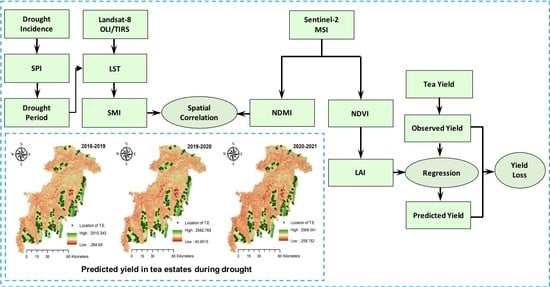An Assessment of Drought Stress in Tea Estates Using Optical and Thermal Remote Sensing
Abstract
:1. Introduction
2. Materials and Methods
2.1. Study Area
2.2. Precipitation Data and the SPI Calculation
2.3. Field Survey and Ground Reference Information
2.4. Remote Sensing Data
2.4.1. Estimation of Land Surface Temperature (LST)
2.4.2. Estimation of Soil Moisture Index (SMI)
2.4.3. Estimation of Normalized Difference Moisture Index (NDMI)
2.5. Statistical Analysis
2.6. Validation of Yield in the Drought Period
3. Result
3.1. Standardized Precipitation Index (SPI) and Drought Classification
3.2. Land Surface Temperature (LST)
3.3. Soil Moisture Index (SMI)
3.4. Normalized Difference Moisture Index (NDMI)
3.5. Spatial Correlation between the SMI and NDMI
3.6. Validation of Tea Yield in the Drought Period
4. Discussion
5. Conclusions
Author Contributions
Funding
Data Availability Statement
Acknowledgments
Conflicts of Interest
References
- Nalina, M.; Saroja, S.; Rajkumar, R.; Radhakrishnan, B.; Chandrashekara, K.N. Variations in quality constituents of green tea leaves in response to drought stress under south Indian condition. Sci. Hortic. 2018, 233, 359–369. [Google Scholar] [CrossRef]
- Ahmed, S.; Stepp, J.R.; Kapuscinski, A.R.; Méndez, E. Beyond yields: Climate change effects on specialty crop quality and agroecological management. Elem. Sci. Anthr. 2016, 4, 000092. [Google Scholar] [CrossRef] [Green Version]
- Anjum, S.A.; Xie, X.Y.; Wang, L.C.; Saleem, M.F.; Man, C.; Lei, W. Morphological, physiological, and biochemical responses of plants to drought stress. Afr. J. Agric. Res. 2011, 6, 2026–2032. [Google Scholar] [CrossRef]
- Shao, H.B.; Chu, L.Y.; Jaleel, C.A.; Manivannan, P.; Panneerselvam, R.; Shao, M.A. Understanding water deficit stress-induced changes in the basic metabolism of higher plants–biotechnologically and sustainably improving agriculture and the ecoenvironment in arid regions of the globe. Crit. Rev. Biotechnol. 2009, 29, 131–151. [Google Scholar] [CrossRef]
- Zhou, L.; Xu, H.; Mischke, S.; Meinhardt, L.W.; Zhang, D.; Zhu, X.; Li, X.; Fang, W. Exogenous abscisic acid significantly affects proteome in tea plant (Camellia sinensis) exposed to drought stress. Hortic. Res. 2014, 1, 14029. [Google Scholar] [CrossRef] [Green Version]
- Nalina, M.; Saroja, S.; Chakravarthi, M.; Rajkumar, R.; Radhakrishnan, B.; Chandrashekara, K.N. Water deficit-induced oxidative stress and differential response in antioxidant enzymes of tolerant and susceptible tea cultivars under field condition. Acta Physiol. Plant. 2021, 43, 10. [Google Scholar] [CrossRef]
- Hajiboland, R. Environmental and nutritional requirements for tea cultivation. Folia Hortic. 2017, 29, 199–220. [Google Scholar] [CrossRef] [Green Version]
- Wijeratne, M.A. Vulnerability of Sri Lanka tea production to global climate change. Water Air Soil Pollut. 1996, 92, 87–94. [Google Scholar] [CrossRef]
- International Tea Committee. Annual Bulletin of Statistics; International Tea Committee Ltd.: London, UK, 2017. [Google Scholar]
- Kamruzzaman, M.; Parveen, S.; Das, A.C. Livelihood improvement of tea garden workers: A scenario of marginalized women group in Bangladesh. Asian J. Agric. Ext. Econ. Soc. 2015, 7, 1–7. [Google Scholar] [CrossRef]
- Das, A.C.; Noguchi, R.; Ahamed, T. Integrating an expert system, GIS, and satellite remote sensing to evaluate land suitability for sustainable tea production in Bangladesh. Remote Sens. 2020, 12, 4136. [Google Scholar] [CrossRef]
- Guo, Y.; Zhao, S.; Zhu, C.; Chang, X.; Yue, C.; Wang, Z.; Lin, Y.; Lai, Z. Identification of drought-responsive miRNAs and physiological characterization of tea plant (Camellia sinensis L.) under drought stress. BMC Plant Biol. 2017, 17, 211. [Google Scholar] [CrossRef] [Green Version]
- AghaKouchak, A.; Farahmand, A.; Melton, F.S.; Teixeira, J.; Anderson, M.C.; Wardlow, B.D.; Hain, C.R. Remote sensing of drought: Progress, challenges, and opportunities. Rev. Geophys. 2015, 53, 452–480. [Google Scholar] [CrossRef] [Green Version]
- Wilhite, D.A. Drought and Water Crises: Science, Technology, and Management Issues; CRC Press, Taylor and Francis Group: Boca Raton, FL, USA, 2005; pp. 1–432. ISBN 978-1-4200-2838-6. [Google Scholar]
- Brown, J.F.; Reed, B.C.; Hyes, M.J.; Wilhite, A.D.; Hubbard, K. A prototype Drought Monitoring System Integrating Climate and Satellite Data, Pecora 15/Land Satellite Information IV/ ISPRS Commission I/FIEOS 2002. Available online: http://www.isprs.org/commission1/proceedings02/paper/00074 (accessed on 15 April 2021).
- Murad, H.; Islam, A.K.M.S. Drought assessment using remote sensing and GIS in north-west region of Bangladesh. In Proceedings of the 3rd International Conference on Water & Flood Management, Dhaka, Bangladesh, 8–10 January 2011; pp. 797–804. [Google Scholar]
- Mishra, A.K.; Singh, V.P. A review of drought concepts. J. Hydrol. 2010, 354, 202–216. [Google Scholar] [CrossRef]
- Kamruzzaman, M.; Hwang, S.; Cho, J.; Jang, M.W.; Jeong, H. Evaluating the spatiotemporal characteristics of agricultural drought in Bangladesh using effective drought index. Water 2019, 11, 2437. [Google Scholar] [CrossRef] [Green Version]
- Guttman, N.B. Comparing the palmer drought index and the standardized precipitation index. J. Am. Water Resour. Assoc. 1998, 34, 113–121. [Google Scholar] [CrossRef]
- Nemani, R.; Hashimoto, H.; Votava, P.; Melton, F.; Wang, W.; Michaelis, A.; Mutch, L.; Milesi, C.; Hiatt, S.; White, M. Monitoring and forecasting ecosystem dynamics using the terrestrial observation and prediction system (TOPS). Remote Sens. Environ. 2009, 113, 1497–1509. [Google Scholar] [CrossRef]
- Caccamo, G.; Chisholm, L.A.; Bradstock, R.A.; Puotinen, M.L. Assessing the sensitivity of MODIS to monitor drought in high biomass ecosystems. Remote Sens. Environ. 2011, 115, 2626–2639. [Google Scholar] [CrossRef]
- Van Niel, T.G.; McVicar, T.R.; Fang, H.; Liang, S. Calculating environmental moisture for per-field discrimination of rice crops. Int. J. Remote Sens. 2003, 24, 885–890. [Google Scholar] [CrossRef]
- Gutman, G.G. Towards monitoring droughts from space. J. Clim. 1990, 3, 282–295. [Google Scholar] [CrossRef] [Green Version]
- Krishna, T.M.; Ravikumar, G.; Krishnaveni, M. Remote sensing based agricultural drought assessment in Palar basin of Tamil Nadu state, India. J Indian Soc Remote Sens. 2009, 37, 9–20. [Google Scholar] [CrossRef]
- Muthumanickam, D.; Kannan, P.; Kumaraperumal, R.; Natarajan, S.; Sivasamy, R.; Poongodi, C. Drought assessment and monitoring through remote sensing and GIS in western tracts of Tamil Nadu, India. Int. J. Remote Sens. 2011, 32, 5157–5176. [Google Scholar] [CrossRef]
- Xi, Z.; Lu, D.; Liu, L.; Ge, H. Detection of drought-induced Hickory disturbances in western Lin An county, China, using multitemporal Landsat imagery. Remote Sens. 2016, 8, 345. [Google Scholar] [CrossRef] [Green Version]
- Razali, S.M.; Atucha, A.A.M.; Nuruddin, A.A.; Hamid, H.A.; Shafri, H.Z.M. Monitoring vegetation drought using MODIS remote sensing indices for natural forest and plantation areas. J. Spat. Sci. 2016, 61, 157–172. [Google Scholar] [CrossRef]
- Xulu, S.; Peerbhay, K.; Gebreslasie, M.; Ismail, R. Drought influence on forest plantations in Zululand, South Africa, using MODIS time-series and climate data. Forests 2018, 9, 528. [Google Scholar] [CrossRef] [Green Version]
- Yang, Y.; Anderson, M.; Gao, F.; Hain, C.; Noormets, A.; Sun, G.; Wynne, R.; Thomas, V.; Sun, L. Investigating impacts of drought and disturbance on evapotranspiration over a forested landscape in North Carolina, USA using high spatiotemporal resolution remotely sensed data. Remote Sens. Environ. 2020, 238, 111018. [Google Scholar] [CrossRef]
- Gupta, N.; Gupta, P.P.; Pramanik, P.; Saikia, A.; Sengupta, L.; Bhagat, R.M.; Bhattacharya, N. Integration of geoinformatics and wireless sensors for smart agriculture in tea. In Proceedings of the Second International Conference on Remote Sensing and Geoinformation of the Environment (RSCy2014), Paphos, Cyprus, 12 August 2014; SPIE: Bellingham, WA, USA, 2014; Volume 9229, p. 92290w. [Google Scholar] [CrossRef]
- Jiang, S.; Wang, W.; Xiao, G.; Li, Z. Design of wireless sensor node for drought monitoring in tea plantation. In Proceedings of the 2011 International Conference on Electric Information and Control Engineering, Wuhan, China, 15–17 April 2011; IEEE: New York, NY, USA, 2011; pp. 1328–1332. [Google Scholar] [CrossRef]
- Sun, D.; Jiang, S.; Wang, W.; Tang, J. WSN design and implementation in a tea plantation for drought monitoring. In Proceedings of the 2010 International Conference on Cyber-Enabled Distributed Computing and Knowledge Discovery, Huangshan, China, 10–12 October 2010; IEEE: New York, NY, USA, 2010; pp. 156–159. [Google Scholar] [CrossRef]
- Bangladesh Tea Board. Statistical Handbook on Bangladesh Tea Industry 2019; Project Development Unit; Bangladesh Tea Board: Sreemangal, Bangladesh, 2020; Volume 8, pp. 1–146.
- Habibie, M.I.; Noguchi, R.; Matsushita, S.; Ahamed, T. Development of micro-level classifiers from land suitability analysis for drought-prone areas in Indonesia. Remote Sens. Appl. Soc. Environ. 2020, 20, 100421. [Google Scholar] [CrossRef]
- Paulo, A.A.; Rosa, R.D.; Pereira, L.S. Climate trends and behaviour of drought indices based on precipitation and evapotranspiration in Portugal. Nat. Hazards Earth Syst. Sci. 2012, 12, 1481–1491. [Google Scholar] [CrossRef]
- Paulo, A.A.; Pereira, L.S. Drought concepts and characterization: Comparing drought indices applied at local and regional scales. Water Int. 2006, 31, 37–49. [Google Scholar] [CrossRef]
- World Meteorological Organization. Standardized Precipitation Index User Guide (WMO-No.1090); WMO: Geneva, Switzerland, 2012; Available online: https://wamis.org/agm/pubs/SPI/WMO_1090_EN.pdf (accessed on 15 April 2021).
- Peterson, T.C.; Vose, R.S. An overview of the global historical climatology network temperature database. Bull. Am. Meteorol. Soc. 1997, 78, 2837–2849. [Google Scholar] [CrossRef] [Green Version]
- McKee, T.B.; Doesken, N.J.; Kleist, J. The relationship of drought frequency and duration to time scale. In Proceedings of the 8th Conference on Applied Climatology, Anaheim, CA, USA, 17–22 January 1993; Volume 17, pp. 179–183. Available online: https://climate.colostate.edu/pdfs/relationshipofdroughtfrequency.pdf (accessed on 15 April 2021).
- Alam, A.T.M.J.; Rahman, M.S.; Saadat, A.H.M.; Huq, M.M. Gamma Distribution and its Application of Spatially Monitoring Meteorological Drought in Barind, Bangladesh. J. Environ. Sci. Nat. Resour. 2013, 5, 287–293. [Google Scholar] [CrossRef]
- Zhang, D.; Zhou, G. Estimation of soil moisture from optical and thermal remote sensing: A review. Sensors 2016, 16, 1308. [Google Scholar] [CrossRef] [PubMed] [Green Version]
- Binte Mostafiz, R.; Noguchi, R.; Ahamed, T. Agricultural land suitability assessment using satellite remote sensing-derived soil-vegetation indices. Land 2021, 10, 223. [Google Scholar] [CrossRef]
- Habibie, M.I.; Noguchi, R.; Shusuke, M.; Ahamed, T. Land suitability analysis for maize production in Indonesia using satellite remote sensing and GIS-based multicriteria decision support system. GeoJournal 2019, 1–31. [Google Scholar] [CrossRef]
- de Jesus, J.B.; Santana, I.D.M. Estimation of land surface temperature in caatinga area using Landsat 8 data. J. Hyperspectral Remote Sens. 2017, 7, 150–157. [Google Scholar] [CrossRef]
- Fang, B.; Kansara, P.; Dandridge, C.; Lakshmi, V. Drought monitoring using high spatial resolution soil moisture data over Australia in 2015–2019. J. Hydrol. 2021, 594, 125960. [Google Scholar] [CrossRef]
- Yin, J.; D’Odorico, P.; Porporato, A. Soil moisture dynamics in water-limited ecosystems. In Dryland Ecohydrology, 2nd ed.; D’Odorico, P., Porporato, A., Runyan, C.W., Eds.; Springer: Cham, Switzerland, 2019; pp. 31–48. ISBN 978-3-030-23269-6. [Google Scholar]
- Wang, L.; Qu, J.J. Satellite remote sensing applications for surface soil moisture monitoring: A review. Front. Earth Sci. China 2009, 3, 237–247. [Google Scholar] [CrossRef]
- Saha, A.; Patil, M.; Goyal, V.C.; Rathore, D.S. Assessment and impact of soil moisture index in agricultural drought estimation using remote sensing and GIS techniques. Proceedings 2019, 7, 2. [Google Scholar] [CrossRef] [Green Version]
- Enquist, B.J.; Ebersole, J.J. Effects of added water on photosynthesis of Bistorta vivipara: The importance of water relations and leaf nitrogen in two alpine communities, Pikes peak, Colorado, U.S.A. Arct. Alp. Res. 1994, 26, 29–34. [Google Scholar] [CrossRef]
- Serrano, J.; Shahidian, S.; Marques da Silva, J. Evaluation of Normalized Difference Water Index as a tool for monitoring pasture seasonal and inter-annual variability in a Mediterranean agro-silvo-pastoral system. Water 2019, 11, 62. [Google Scholar] [CrossRef] [Green Version]
- Gao, B.C. NDWI—A normalized difference water index for remote sensing of vegetation liquid water from space. Remote Sens. Environ. 1996, 58, 257–266. [Google Scholar] [CrossRef]
- Korhonen, L.; Packalen, P.; Rautiainen, M. Comparison of Sentinel-2 and Landsat 8 in the estimation of boreal forest canopy cover and leaf area index. Remote Sens. Environ. 2017, 195, 259–274. [Google Scholar] [CrossRef]
- Tewari, S.; Kulhavy, J.; Rock, B.N.; Hadas, P. Remote monitoring of forest response to changed soil moisture regime due to river regulation. J. For. Sci. 2003, 49, 429–438. [Google Scholar] [CrossRef] [Green Version]
- Tuvshinbayar, D.; Erdenetuya, B.; Erkhembayar, E.; Batbileg, B.; Sarangerel, J. Some Results of crop stress monitoring by remote sensing in northern Mongolia. Mong. J. Agric. Sci. 2017, 21, 59–63. [Google Scholar] [CrossRef] [Green Version]
- West, H.; Quinn, N.; Horswell, M. Remote sensing for drought monitoring & impact assessment: Progress, past challenges and future opportunities. Remote Sens. Environ. 2019, 232, 111291. [Google Scholar] [CrossRef]
- Chen, M.; Zhang, Y.; Yao, Y.; Lu, J.; Pu, X.; Hu, T.; Wang, P. Evaluation of the OPTRAM Model to retrieve soil moisture in the Sanjiang Plain of Northeast China. Earth Space Sci. 2020, 7, e2020EA001108. [Google Scholar] [CrossRef]
- Sabaghy, S.; Walker, J.P.; Renzullo, L.J.; Jackson, T.J. Spatially enhanced passive microwave derived soil moisture: Capabilities and opportunities. Remote Sens. Environ. 2018, 209, 551–580. [Google Scholar] [CrossRef]
- Rahimzadeh-Bajgiran, P.; Omasa, K.; Shimizu, Y. Comparative evaluation of the vegetation dryness index (VDI), the temperature vegetation dryness index (TVDI) and the improved TVDI (iTVDI) for water stress detection in semi-arid regions of Iran. ISPRS J. Photogramm. Remote Sens. 2012, 68, 1–12. [Google Scholar] [CrossRef]
- Wang, Z.; Guo, P.; Wan, H.; Tian, F.; Wang, L. Integration of microwave and optical / infrared derived datasets from multi-satellite products for drought monitoring. Water 2020, 12, 1504. [Google Scholar] [CrossRef]
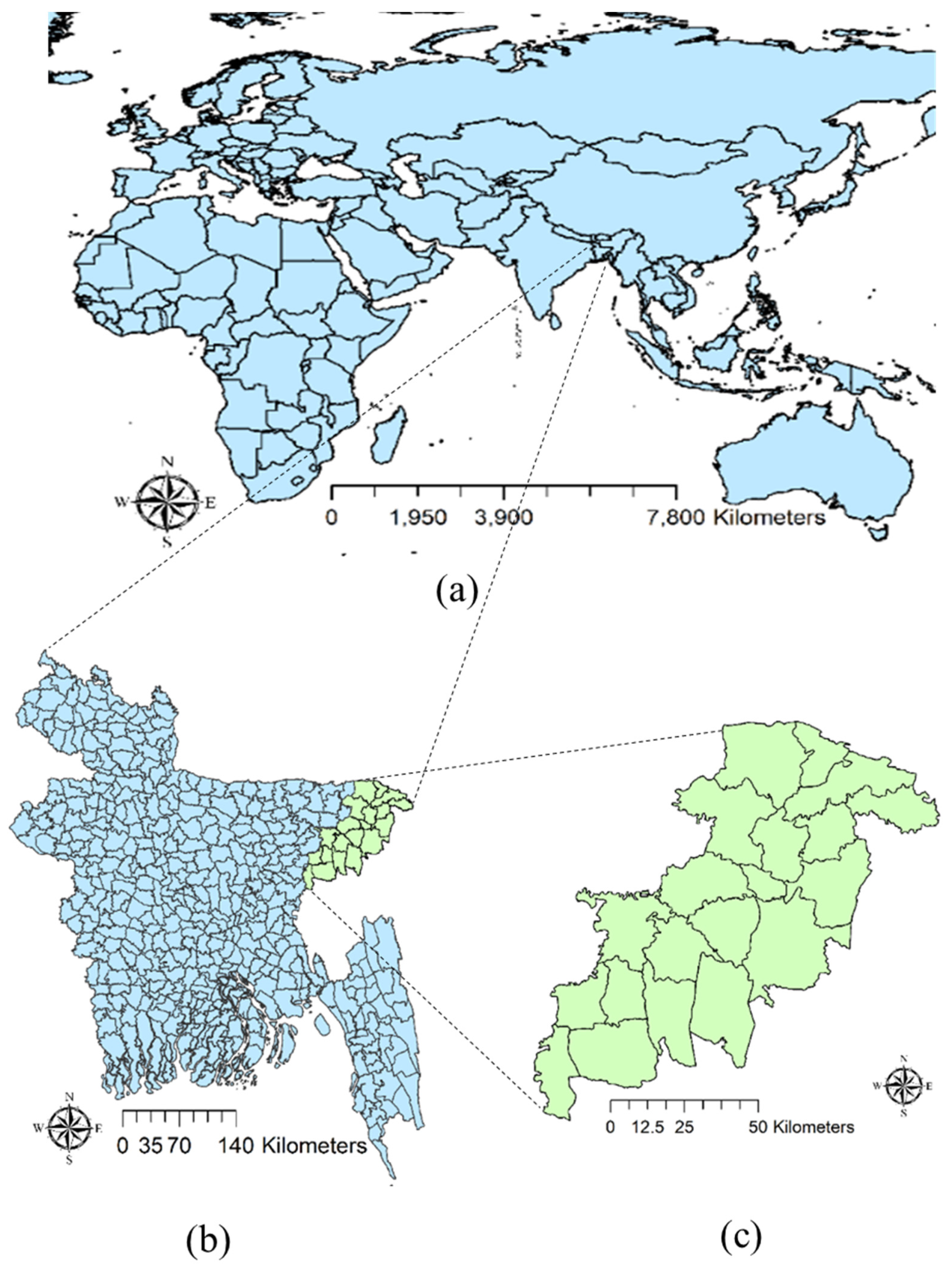

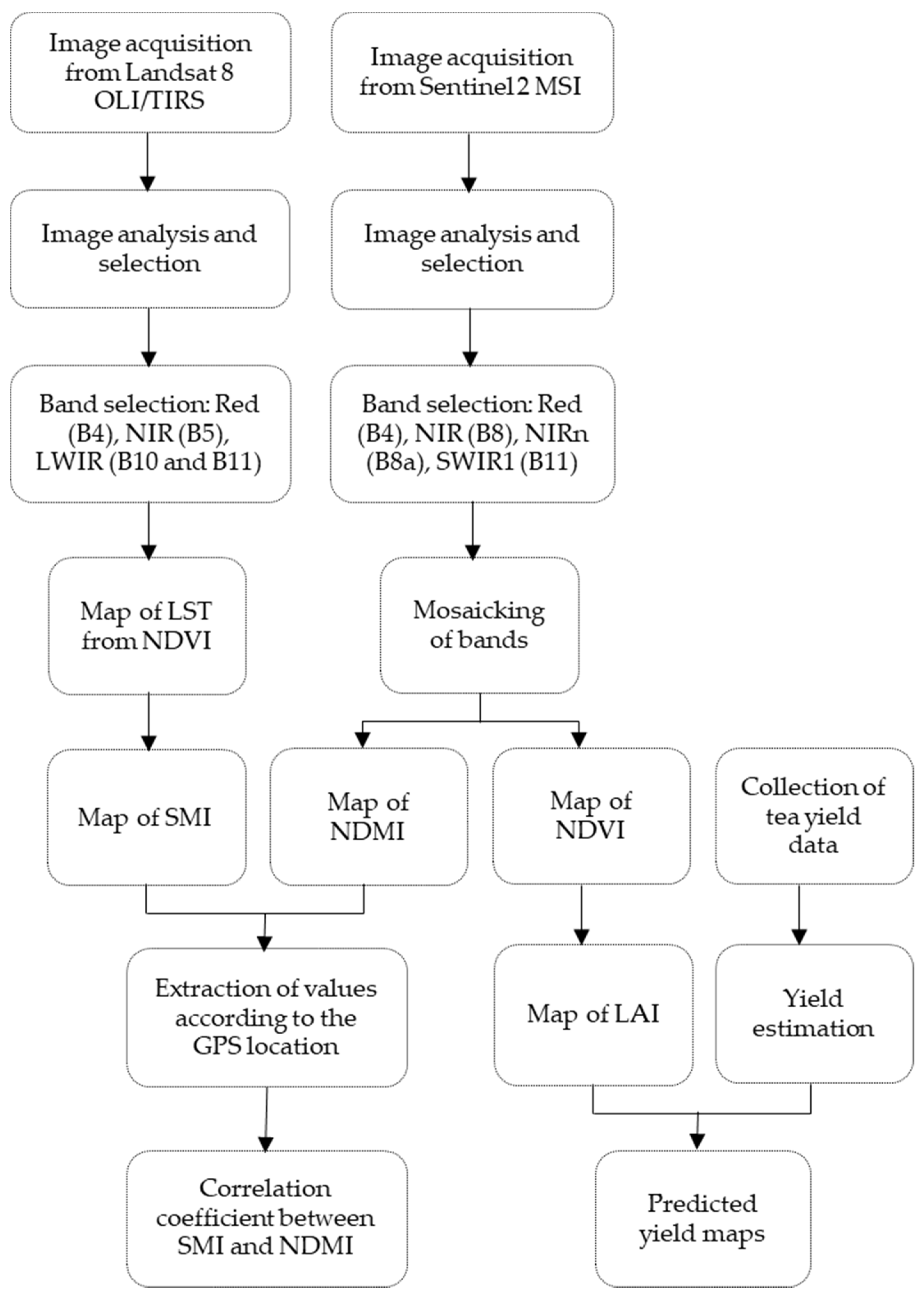
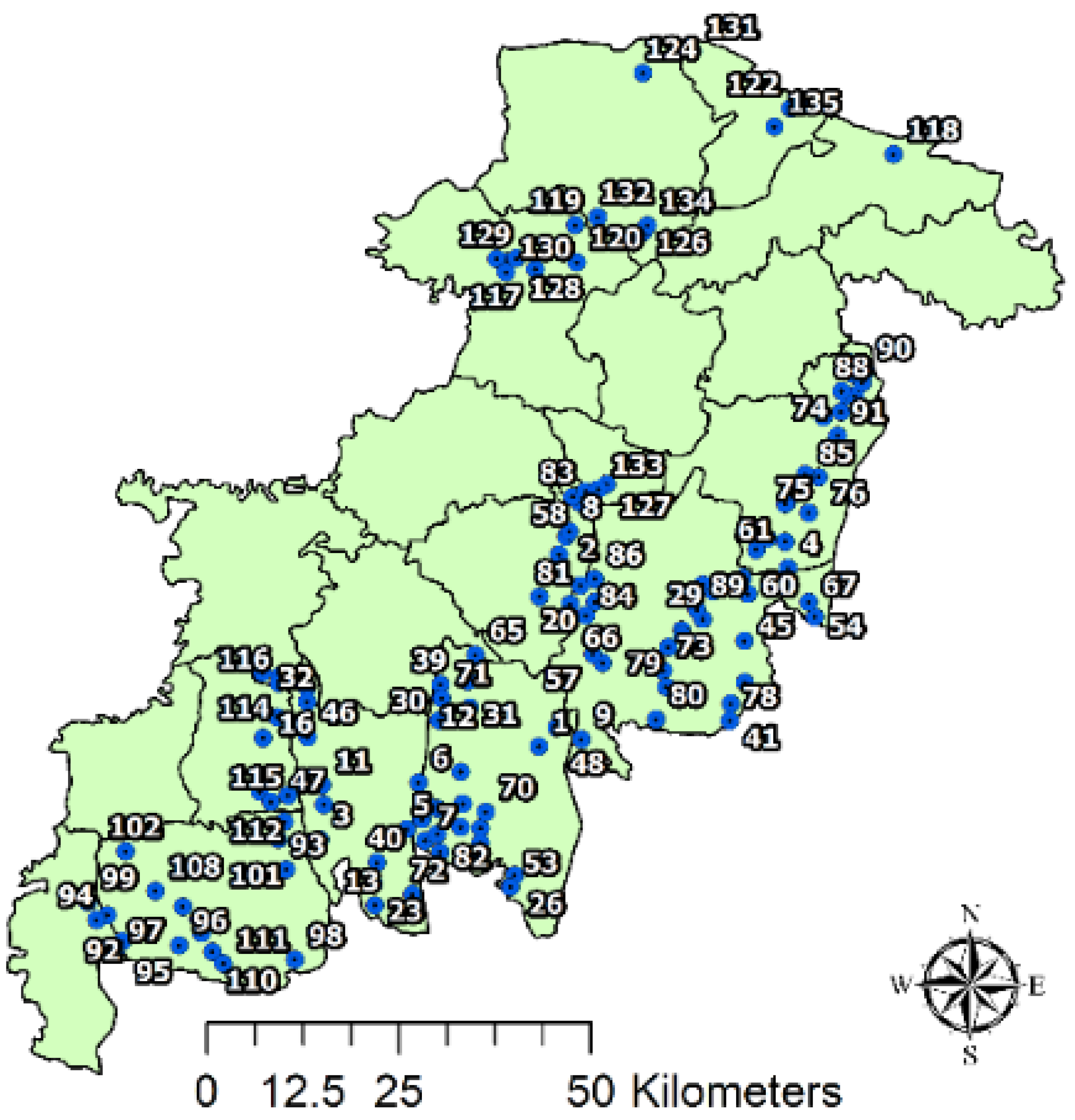
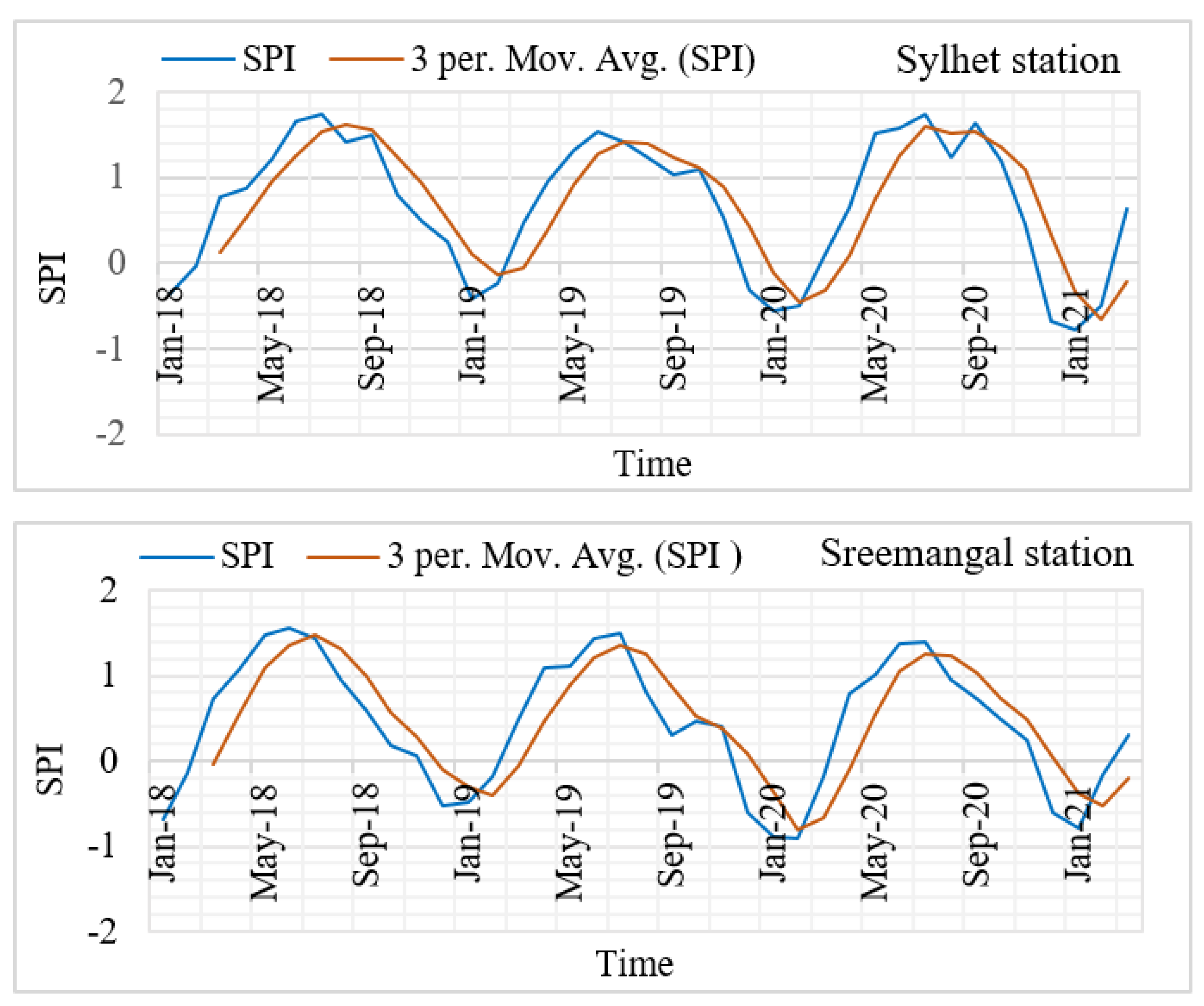
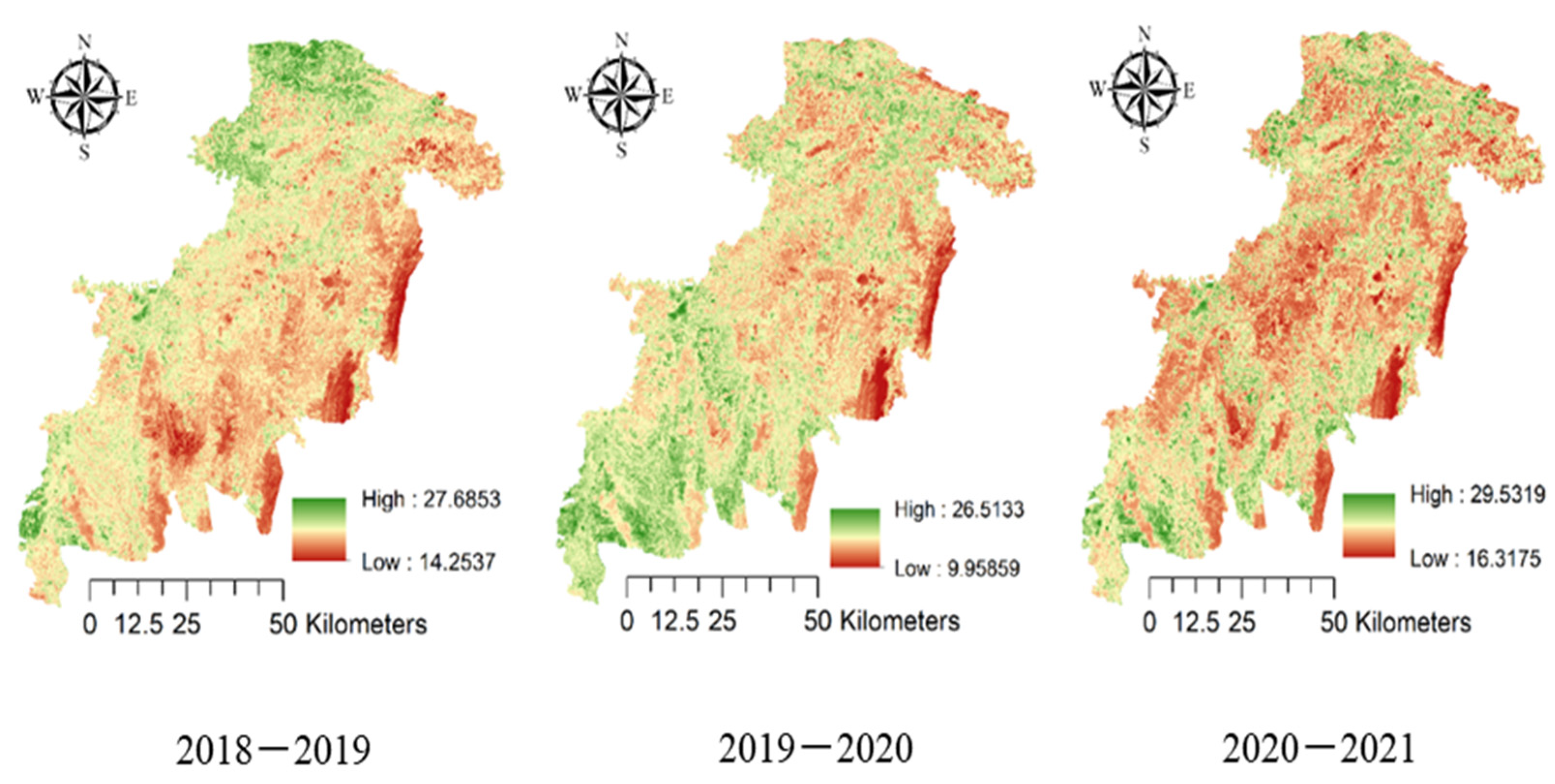

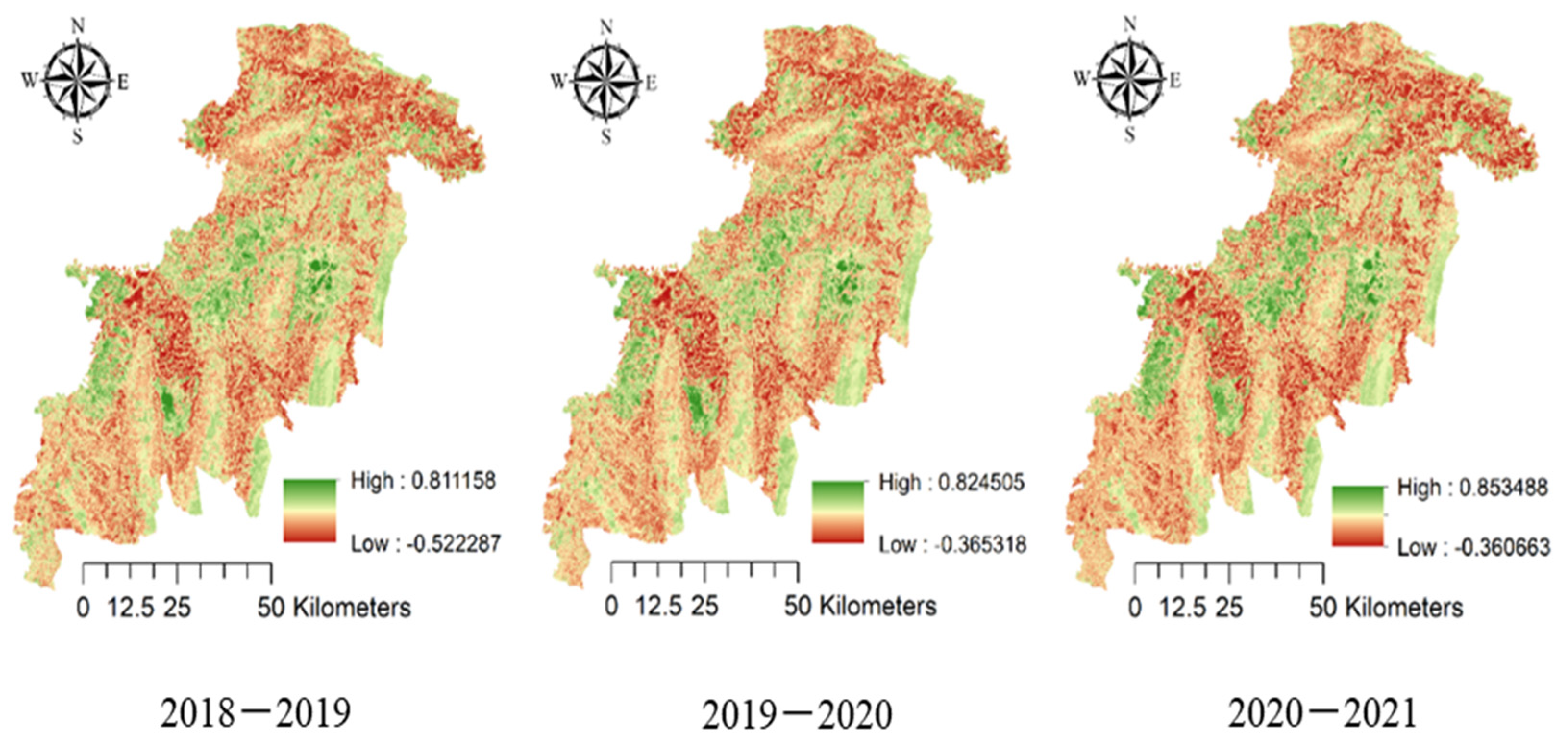
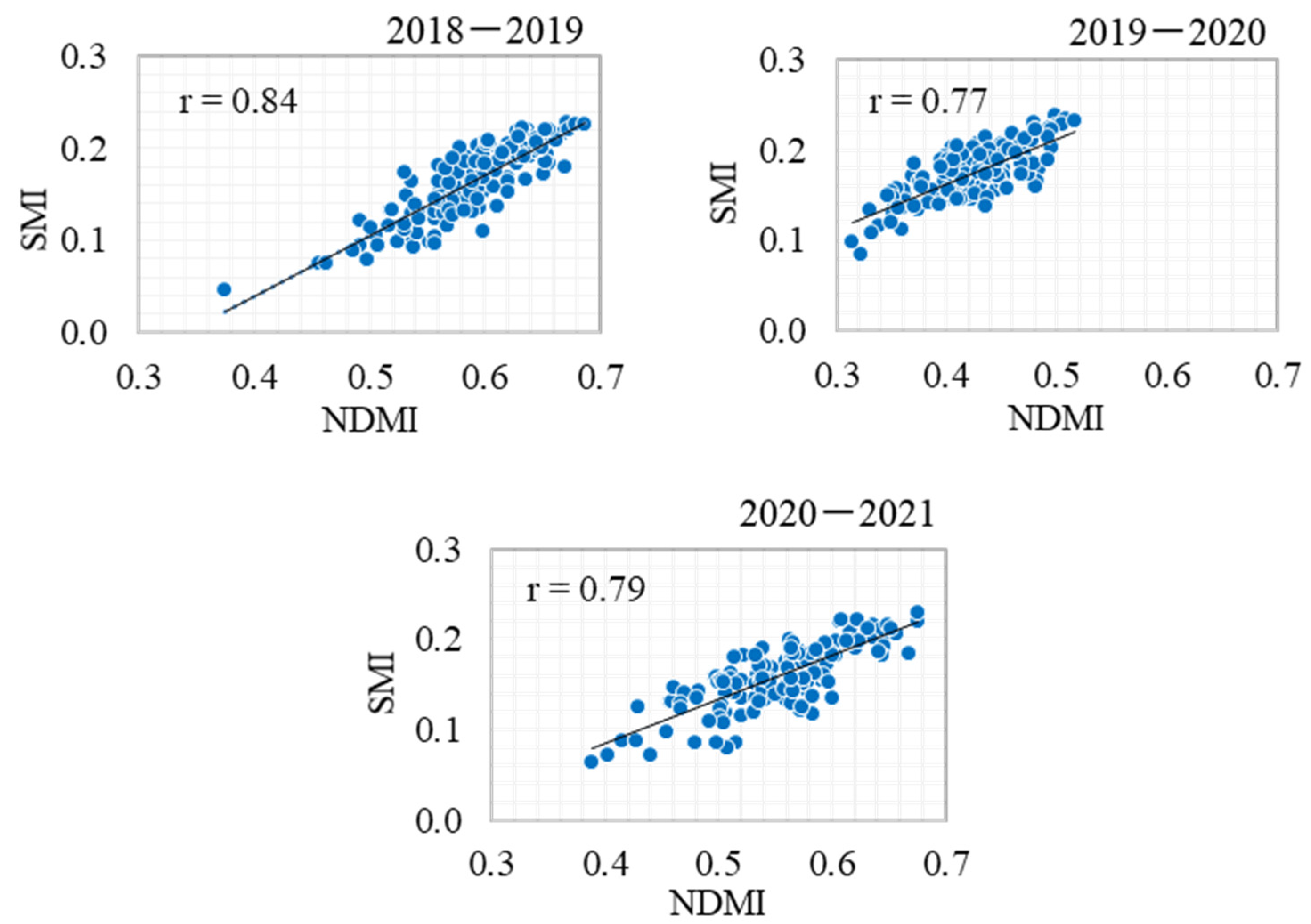

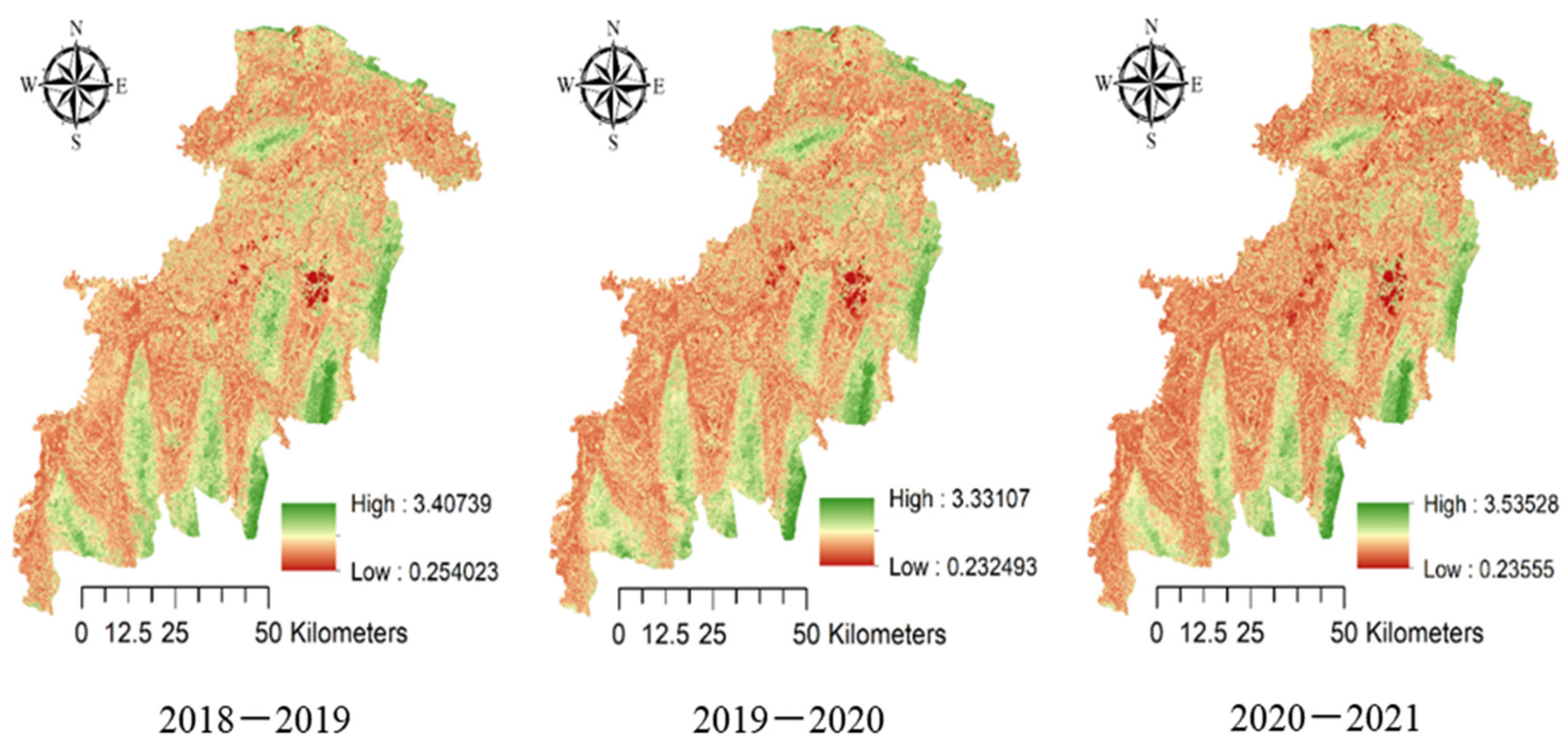

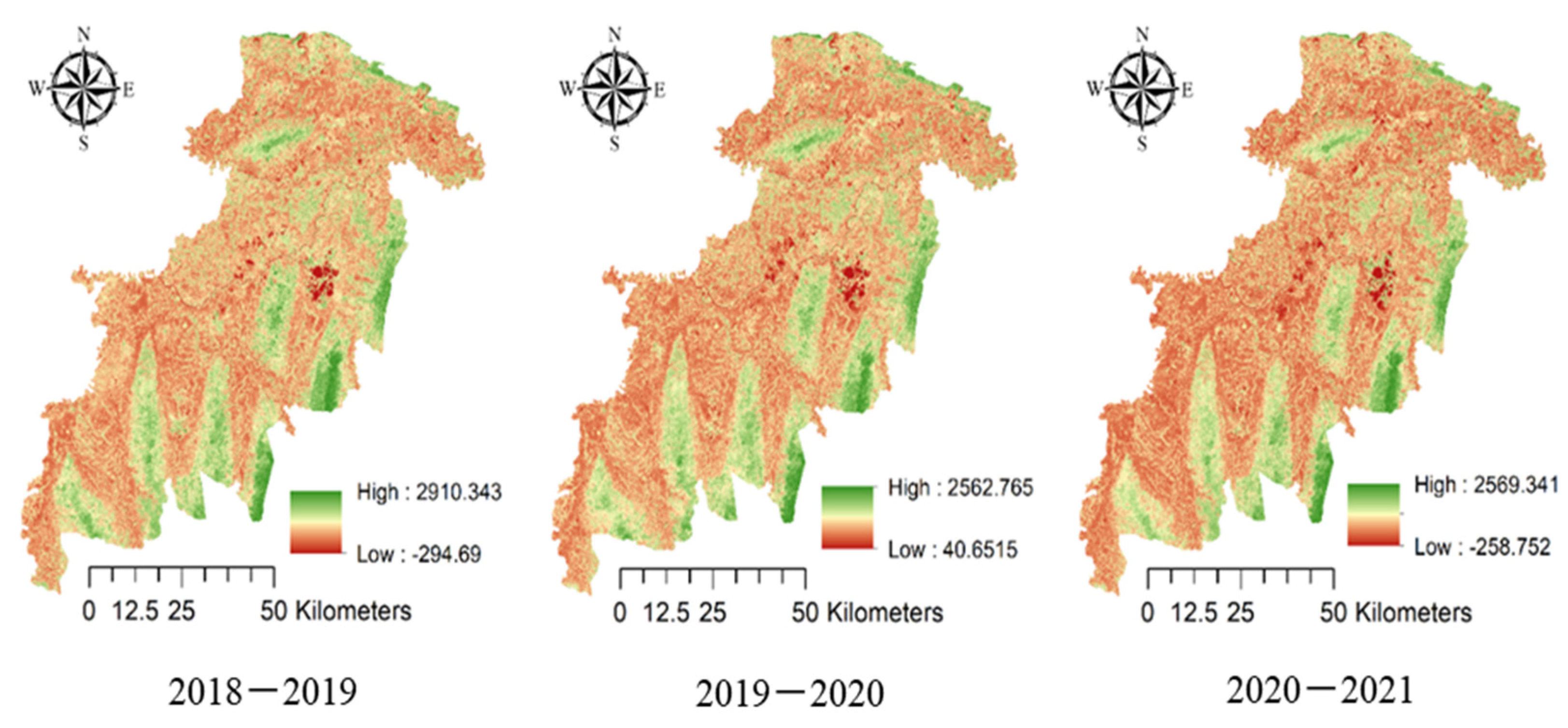
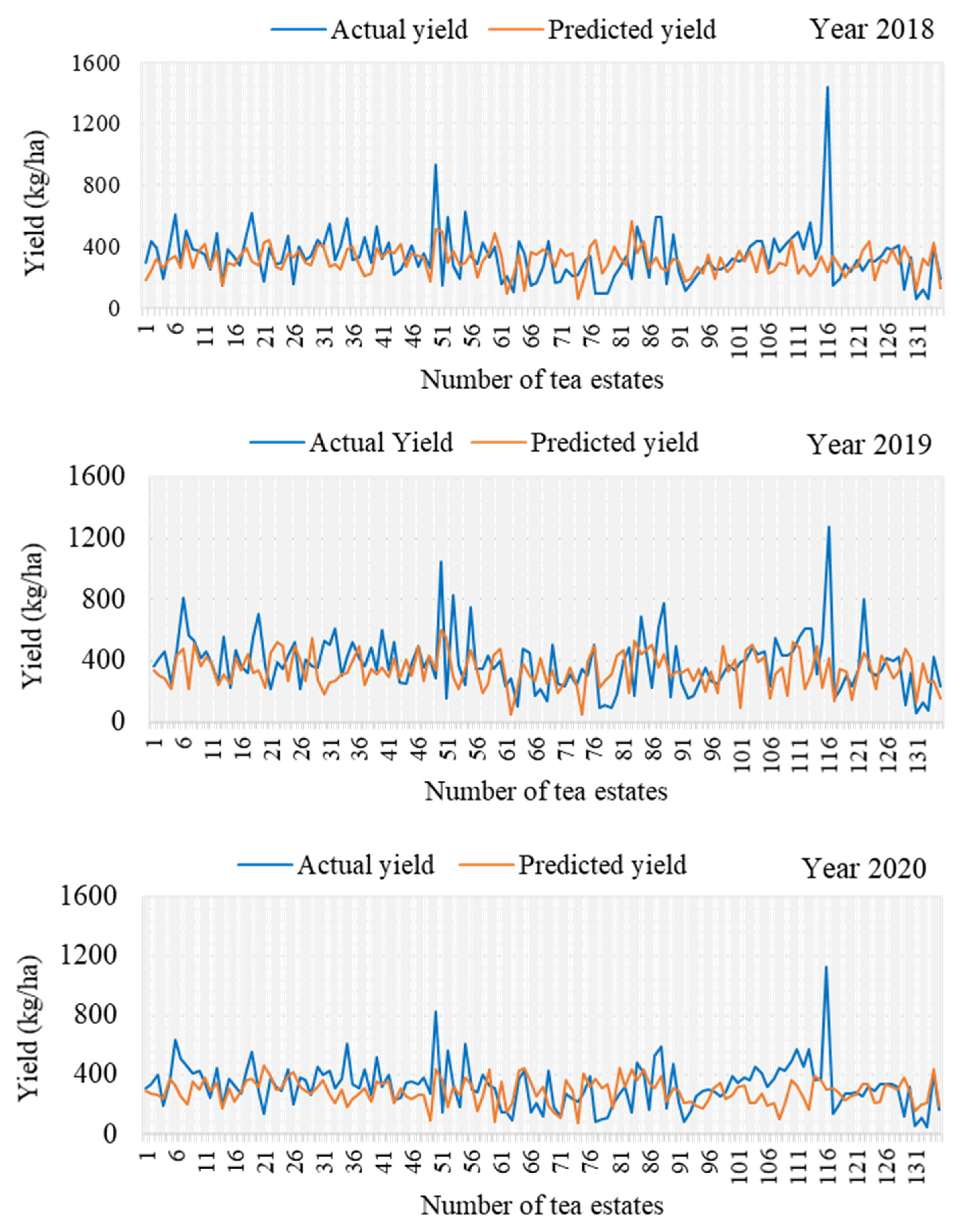
| Drought Classes | SPI Level | No. of Months Affected | Frequency (%) | ||
|---|---|---|---|---|---|
| Sylhet | Sreemangal | Sylhet | Sreemangal | ||
| Extremely wet | >3.0 to 3.0 | - | - | - | - |
| Moderately wet | 3.0 to 2.0 | - | - | - | - |
| Near-normal | 2.0 to 1.0 | 15 | 11 | 38.46 | 28.21 |
| Normal | 1.0 to 0 | 14 | 16 | 35.90 | 41.02 |
| Moderately dry | 0 to −1.0 | 10 | 12 | 25.64 | 30.77 |
| Severely dry | −1.0 to −2.0 | - | - | - | - |
| Extremely dry | −2.0 to −3.0 | - | - | - | - |
Publisher’s Note: MDPI stays neutral with regard to jurisdictional claims in published maps and institutional affiliations. |
© 2021 by the authors. Licensee MDPI, Basel, Switzerland. This article is an open access article distributed under the terms and conditions of the Creative Commons Attribution (CC BY) license (https://creativecommons.org/licenses/by/4.0/).
Share and Cite
Das, A.C.; Noguchi, R.; Ahamed, T. An Assessment of Drought Stress in Tea Estates Using Optical and Thermal Remote Sensing. Remote Sens. 2021, 13, 2730. https://doi.org/10.3390/rs13142730
Das AC, Noguchi R, Ahamed T. An Assessment of Drought Stress in Tea Estates Using Optical and Thermal Remote Sensing. Remote Sensing. 2021; 13(14):2730. https://doi.org/10.3390/rs13142730
Chicago/Turabian StyleDas, Animesh Chandra, Ryozo Noguchi, and Tofael Ahamed. 2021. "An Assessment of Drought Stress in Tea Estates Using Optical and Thermal Remote Sensing" Remote Sensing 13, no. 14: 2730. https://doi.org/10.3390/rs13142730
APA StyleDas, A. C., Noguchi, R., & Ahamed, T. (2021). An Assessment of Drought Stress in Tea Estates Using Optical and Thermal Remote Sensing. Remote Sensing, 13(14), 2730. https://doi.org/10.3390/rs13142730







